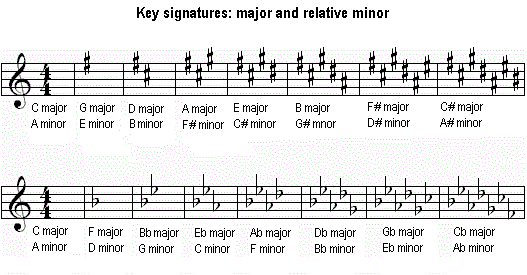Major Scales and Key Signatures for the Violin
/It would be pretty boring we played all music in the same key. But we can rearrange where the half steps are in a scale and get 12 different major keys. (Do you know how many half steps there are in a scale? That’s right, 12!) A major key can be built off of every half step in a scale.
C D♭ D E♭ E F F# G A♭ A B♭ B
You might be wondering why I sharped some notes and made others flat. That’s because you will play something in B♭ a lot more than you will play something in the key of A#. Look at the piano, B♭ and A# are the same note. That means they are enharmonic equivalents: the same note written two different ways.
Major Scales
How do major scales work? Well it all depends on the arrangement of whole and half steps. Start with C major. Can you write half or whole in between each note? Remember “Buy Chocolate” and “Eat Fudge". Half steps are going to be between those two pairs of white keys that touch on the piano keyboard.
This is the order you get. Whole Whole Half Whole Whole Whole Half. I sum it up like this: WWHWWWH.
That’s the order of half and whole steps for all major scales which is why major scales sound the same. They have the same relationship between the notes. Try this exercise. Print out some blank sheet music. Notate an E (the first line on the treble staff). Without looking at a scale book and without thinking about your key signature for E, begin writing the scale just by the order of whole and half steps. Now compare your scale to an E major scale in your scale book. If you really want to give yourself a workout, try doing this for the more complicated scales like A#.
So if you’ve ever wondered why the Key of G major has one sharp—F#, this is why. Start on a G, follow your half step whole step pattern for the major scale and you will end up with F#.
All scales have two sets of half steps. Think of the Key of C as your vanilla scale with your basic BC and EF half steps. Every time you add one sharp, you are changing these two sets of half steps. In the key of G, you haven’t changed anything with B or C so they are still half steps. But E and F are no longer half steps because you had to sharp that F. Now F# and G are half steps.
What’s up with all those sharps and flats? They look like they are completely random but they always occur in a certain order. If you have one sharp, it will always be F#. If you have two sharps they will always be F# and C#. The order goes like this:
F# C# G# D# A# E# B#
Use the mnemonic “Fat Cats Go Down Allies Eating Birds” to help you remember the order.
For flats, the order is the reverse of what it is for sharps.
B♭ E♭ A♭ D♭ G♭ C♭ F♭
Remember “Bead Go Catch Fish” for flats.
You can number each note in your scale. We call these scale degrees. The numbers above the notes are the scale degrees. Each note in a scale also has a name which are written below the note in the following picture.
Don't worry about remembering the name for each scale degree. The most important ones are tonic, dominant, and the leading tone. Scale degrees and scale names are the same for major and minor keys.
Why do we call the seventh scale degree a leading tone? Because it wants to lead to tonic again. Try playing a scale and stop on the leading tone. You’ll be itching to play the tonic to feel complete. (Legend has it Mozart’s father would play scales in the morning ending on the leading tone. Young Mozart would jump out of bed, run down stairs, and play the tonic. Brilliant idea to get a prodigy up in the morning.)
You know what key you are playing in based on the key signature at the beginning of the music. Here’s a list of all the major (and their relative minor scales). Don’t worry about the minor scales for now. Try to memorize each key signature up through 5 sharps and 5 flats. In the violin, you will spend most of your time playing in the key signatures with 0-5 sharps or flats so focus on those.




















